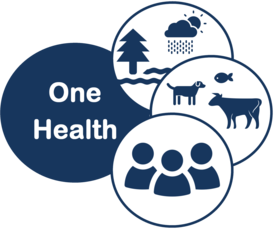
Blue-Green Algae and "One Health"
What is “One Health”?
“One Health” is a term used to recognize that the health of people is connected to the health of animals and the environment. It is a collaborative, multisectoral, and transdisciplinary approach with the goal of achieving optimal health outcomes recognizing the interconnection between people, animals, plants, and their shared environment. While zoonotic diseases are typically among the first One Health issues to come to mind for most people, blue-green algae have been gaining attention as a local, nationwide, and worldwide problem affecting the environment, animals, and people. Blue-green algae can:
- Out-compete more desirable algae in lakes and deplete oxygen levels leading to fish kills and impaired water quality.
- Create toxins which have been implicated in the illnesses and deaths of dogs, birds, cattle, and other animals.
- Cause illness in people who participate in recreational water activities or consume tainted drinking water.
How is the One Health approach to addressing blue-green algae carried out at the state level?
In Wisconsin, state and local agencies work together to investigate both human and animal illnesses suspected of being caused by blue-green algae and their related toxins. Animal illnesses, including illnesses in pets, livestock, and wildlife, are investigated with the understanding that the cause of their illness (i.e., a blue-green algae bloom with elevated concentrations of cyanotoxins) may also pose a risk to human health. Illnesses are reported to local health departments or to the Division of Public Health where those agencies work together, alongside the Department of Natural Resources (DNR) and the State Laboratory of Hygiene, to determine the likelihood that the illness is related to blue-green algae, assess immediate health risks, and intervene to protect the health of the public. Investigations often involve a diverse team of individuals consisting of public health professionals such as health officers, public health nurses, veterinarians, and epidemiologists, as well as water specialists such as limnologists, lake biologists, and microbiologists.
…and at the federal level?
At the federal level, the Centers for Disease Control and Prevention (CDC) maintain a surveillance system for blooms and related illnesses through their reporting platform known as the One Health Harmful Algal Bloom System (OHHABS). This system allows public health agencies and their designated environmental or animal health partners to voluntarily report bloom events and related illnesses in both humans and animals, and combine those related events into one larger report. In Wisconsin, use of this system is centralized and reports are submitted by officials at the Division of Public Health. CDC collects these reports with the goal of learning more about blooms and related illnesses across the United States.
|